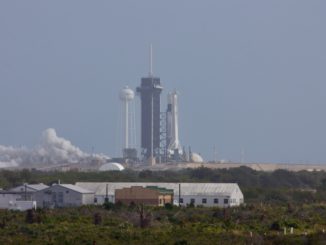A SpaceX Super Heavy-Starship rocket successfully launched on August 26, 2025, marking a significant milestone in the company’s ongoing development of its spacecraft. The mission, launched from SpaceX’s facility in Texas, was particularly noteworthy following a series of three consecutive failures earlier this year.
The launch occurred at 19:30 ET with the Super Heavy’s 33 methane-fueled Raptor engines igniting to propel the 40-story-tall rocket into the atmosphere. Despite experiencing minor damage during re-entry, the spacecraft managed to maintain control and completed a planned powered splashdown in the Indian Ocean.
Initial stages of the flight unfolded smoothly, with the Super Heavy booster operating effectively. The booster successfully separated from the upper stage Starship after propelling it out of the lower atmosphere. A test involving the deliberate shutdown of one of the engines during descent showcased the booster’s ability to compensate for the loss, allowing it to splash down in the Gulf of Mexico as intended.
This successful flight provided a much-needed boost to SpaceX, especially after the previous setbacks. Workers at SpaceX’s facilities in both Texas and California celebrated the achievement, reflecting their relief and excitement following the earlier failures.
The mission’s success is crucial not only for SpaceX but also for NASA, which is relying on a modified version of the Starship to facilitate lunar missions. NASA aims to use this spacecraft to send astronauts to the Moon by 2027, a timeline that raises concerns given the technical challenges that remain.
Following the launch, SpaceX reported that the Starship deployed eight Starlink satellite simulators, testing its deployment mechanism. Additionally, one of the rocket’s Raptor engines was reignited in space to confirm its restart capability.
During re-entry, the Starship endured extreme temperatures, which tested new heat shield tiles. Though some damage was noted, including a protective skirt breaking apart and partial melting of a control flap, the vehicle’s performance was not significantly affected.
SpaceX aims to develop a fully reusable lunar lander variant of the Starship, which will require multiple launches to refuel before a lunar journey. The company anticipates needing to conduct between 10 to 20 Super Heavy-tanker flights to ensure sufficient propellant for lunar missions.
The challenges of landing on the Moon with a 16-story-tall rocket are considerable. Uneven terrain and the potential for tip-overs are significant concerns. Observers within the aerospace community have expressed skepticism about meeting the 2027 deadline, citing the numerous technical hurdles that remain.
A senior engineer involved in NASA’s Artemis program stated, “We are not going to go ahead and get a crewed Starship to the Moon by 2030, under any circumstances.” This underscores the urgency for SpaceX to resolve existing issues as it strives to meet ambitious timelines while competing against international entities, including China’s lunar ambitions.
The successful test flight is a crucial step forward for SpaceX as it seeks to address the technical challenges that lie ahead and prepare for future operational missions, which will include launching numerous satellites and potentially ferrying humans to Mars in the long term.
